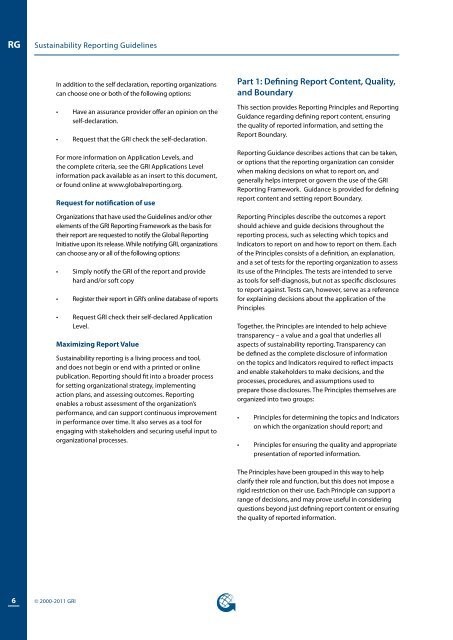G3.1 Sustainability Reporting Guidelines - Global Reporting Initiative
G3.1 Sustainability Reporting Guidelines - Global Reporting Initiative
G3.1 Sustainability Reporting Guidelines - Global Reporting Initiative
Create successful ePaper yourself
Turn your PDF publications into a flip-book with our unique Google optimized e-Paper software.
RG<br />
<strong>Sustainability</strong> <strong>Reporting</strong> <strong>Guidelines</strong><br />
In addition to the self declaration, reporting organizations<br />
can choose one or both of the following options:<br />
• Have an assurance provider offer an opinion on the<br />
self-declaration.<br />
• Request that the GRI check the self-declaration.<br />
For more information on Application Levels, and<br />
the complete criteria, see the GRI Applications Level<br />
information pack available as an insert to this document,<br />
or found online at www.globalreporting.org.<br />
Request for notification of use<br />
Organizations that have used the <strong>Guidelines</strong> and/or other<br />
elements of the GRI <strong>Reporting</strong> Framework as the basis for<br />
their report are requested to notify the <strong>Global</strong> <strong>Reporting</strong><br />
<strong>Initiative</strong> upon its release. While notifying GRI, organizations<br />
can choose any or all of the following options:<br />
• Simply notify the GRI of the report and provide<br />
hard and/or soft copy<br />
• Register their report in GRI’s online database of reports<br />
• Request GRI check their self-declared Application<br />
Level.<br />
Maximizing Report Value<br />
<strong>Sustainability</strong> reporting is a living process and tool,<br />
and does not begin or end with a printed or online<br />
publication. <strong>Reporting</strong> should fit into a broader process<br />
for setting organizational strategy, implementing<br />
action plans, and assessing outcomes. <strong>Reporting</strong><br />
enables a robust assessment of the organization’s<br />
performance, and can support continuous improvement<br />
in performance over time. It also serves as a tool for<br />
engaging with stakeholders and securing useful input to<br />
organizational processes.<br />
Part 1: Defining Report Content, Quality,<br />
and Boundary<br />
This section provides <strong>Reporting</strong> Principles and <strong>Reporting</strong><br />
Guidance regarding defining report content, ensuring<br />
the quality of reported information, and setting the<br />
Report Boundary.<br />
<strong>Reporting</strong> Guidance describes actions that can be taken,<br />
or options that the reporting organization can consider<br />
when making decisions on what to report on, and<br />
generally helps interpret or govern the use of the GRI<br />
<strong>Reporting</strong> Framework. Guidance is provided for defining<br />
report content and setting report Boundary.<br />
<strong>Reporting</strong> Principles describe the outcomes a report<br />
should achieve and guide decisions throughout the<br />
reporting process, such as selecting which topics and<br />
Indicators to report on and how to report on them. Each<br />
of the Principles consists of a definition, an explanation,<br />
and a set of tests for the reporting organization to assess<br />
its use of the Principles. The tests are intended to serve<br />
as tools for self-diagnosis, but not as specific disclosures<br />
to report against. Tests can, however, serve as a reference<br />
for explaining decisions about the application of the<br />
Principles<br />
Together, the Principles are intended to help achieve<br />
transparency – a value and a goal that underlies all<br />
aspects of sustainability reporting. Transparency can<br />
be defined as the complete disclosure of information<br />
on the topics and Indicators required to reflect impacts<br />
and enable stakeholders to make decisions, and the<br />
processes, procedures, and assumptions used to<br />
prepare those disclosures. The Principles themselves are<br />
organized into two groups:<br />
• Principles for determining the topics and Indicators<br />
on which the organization should report; and<br />
• Principles for ensuring the quality and appropriate<br />
presentation of reported information.<br />
The Principles have been grouped in this way to help<br />
clarify their role and function, but this does not impose a<br />
rigid restriction on their use. Each Principle can support a<br />
range of decisions, and may prove useful in considering<br />
questions beyond just defining report content or ensuring<br />
the quality of reported information.<br />
6<br />
© 2000-2011 GRI

















